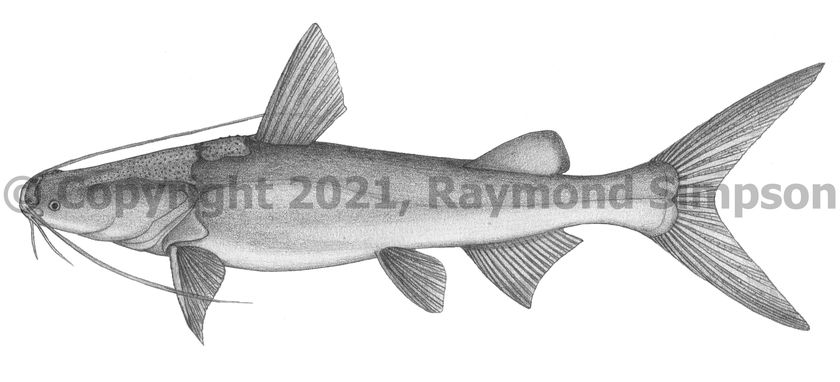
Common Name
Crucifix Sea Catfish
Year Described
Valenciennes [in Cuvier & Valenciennes], 1840
Identification
Dorsal Fin: I, 7
Anal Fin: 17-20
Pectoral Fin: 11 rays
Pelvic Fin: 6
Caudal Fin: 13 branched (6 upper, 7 lower)
Gill Rakers: 15-18 (first arch)
Sciades is defined by the combination of the following characters described in Marceniuk & van der Steen (2017): medial fleshy groove absent or present, a tiny fenestra between frontal and lateral ethmoid, posterior cranial fontanel closed, epiooccipital projecting into dorsal shield, occipital process short and tapering posteriorly, nuchal shield small/medium sized and crescent-shaped, vomerine tooth patch present, accessory tooth plates long, and adipose fin as long as anal fin.
Body elongate and robust with a strongly arched back. Head flattened. Greatest body depth at dorsal fin. Snout broadly rounded or squared off. Nostrils connected by a weak, incomplete furrow. Anterior nostril fleshy and posterior covered by a flap. Cephalic shield large and very rough; extends forward to eyes with a shallow indent in the middle of the head. *Supraoccipital process very short and wide at the base, with a thin posterior extension that fits into a notch in the nuchal plate. Nuchal plate butterfly-shaped, moderate, and rough. Mouth almost terminal. Eye small. There are three pairs of barbels (one maxillary and 2 mental) with the maxillary barbel reaching base of pectoral fin (relatively short compared to other Sciades). A single arched patch of villiform teeth cross maxillary. Vomerine tooth patch present. Accessory patches with moderate posterior extensions in adults and fused to vomerine patch. Dorsal fin high with a strong serrated spine. Pectoral fins about the same size as dorsal fin with strong, weakly serrated spines. Pelvic and anal fins located far back on body. Adipose fin as long as anal fin. Caudal fin strongly forked. No rakers on rear of gill arches. Swimbladder present but smaller than S. parkeri. Body naked.
Color
Body blue-gray to dark gray above grading to whitish below. Fins gray. Caudal lobes and rear edge of adipose fin darker.
Size
Maximum size to 100cmTL but mostly less than 60cm TL.
Habitat
An estuarine species found in lagoons and river mouths. Tolerates a wide range of salinity from pure freshwater to full seawater.
Range
Coastal Colombia to northern Brazil (Amazon mouth).
References
Acero, A. 2002. Ariidae (pp 831-852). In: Carpenter. 2002. The living marine resources of the Western Central Atlantic. Vol. 2: Bony fishes part 1 (Acipenseridae-Grammatidae). FAO Species Identification Guides for Fisheries Purposes. American Society of Ichthyologists and Herpetologists Special Publication No. 5.
Marceniuk, A.P. & van der Steen, P. 2017. Family Ariidae. In: van der Sleen, P., & Albert, J.S. (Eds.). 2017. Field guide to the fishes of the Amazon, Orinoco, and Guianas (Vol. 115). Princeton University Press.
Other Notes
This species has only a weak nasal furrow. Sciades parkeri and S. proops are different from the other three species in body shape, nuchal plate size/shape, swimbladder presence, expression of nasal furrow, and eye position much closer to snout tip. The rearward extension of the supraoccipital process is thin and indents into the nuchal plate in this species. This species also has much shorter barbels as an adult than other members of the genus.